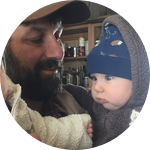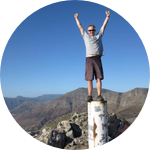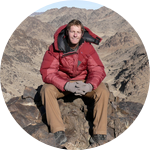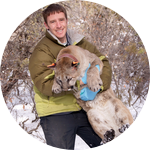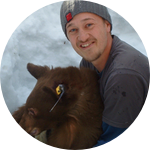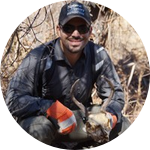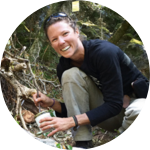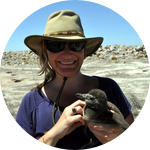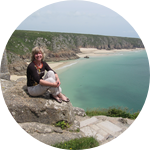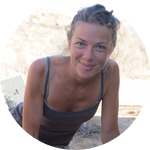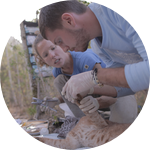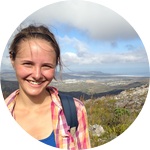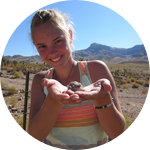About This Project
As global urbanization rapidly expands, wildlife species are increasingly endangered by human activities. We are assessing how the stressors of city life (disease, habitat loss, roads, and pesticides) are affecting caracals (Caracal caracal) in and around Cape Town, South Africa. We are conducting behavioral and genetic assessments and documenting frequent sources of mortality. We are also capitalizing on unique educational opportunities that are affecting conservation across the region.
Ask the Scientists
Join The DiscussionWhat is the context of this research?
Habitat loss and modification drive modern species extinctions. As the urban-wildland interface expands, wildlife are increasingly threatened by the direct and indirect effects of human activities. Roads and urban infrastructure fragment habitat, increase mortality, inhibit gene flow, and alter important behaviors. Non-native species can increase disease exposure for wildlife while exposure to pesticides can impair reproduction, immunity, and survival. Mitigating these threats is essential to conserving species as urban areas expand.
Carnivores may be particularly sensitive to the genetic effects of urbanization and are susceptible to diseases transmitted from domestic animals and pesticide bioaccumulation. Caracals are thus excellent indicators of trends driving global species declines.
What is the significance of this project?
Our research focuses on an understudied and secretive carnivore. We will yield key data concerning minimum habitat requirements and the ability of caracals to respond to the increasingly prevalent disturbances imposed by urbanization. Most urban wildlife studies are conducted in first-world countries, limiting the conservation implications of their findings for developing countries that dominate the globe. Many species have been extirpated from the study area leaving caracals as the largest remaining carnivore. Understanding the effects humans are having on this apex predator is therefore useful at local and global scales. Our data is already guiding conservation action by local management agencies, while our proximity to a major city provides unique public outreach opportunities.
What are the goals of the project?
We will assess the effects of urbanization on caracal behavior using GPS data from tracking collars. We predict that increased prey abundance in human-modified areas will affect movement patterns, while isolation by urbanization will impede dispersal in males. Young males would thus have increased vulnerability to death associated with human activities.
We will examine urbanization as a driver of genomic and epigenomic change. Isolation will likely cause increased inbreeding and decreased genomic variation, yet epigenomic variation (that regulates genome activity independent of the DNA sequence) may facilitate adaptive response to habitat change.
Finally, we will investigate the synergistic threats to caracal survival related to human activities including disease, pesticides, and roads.
Budget
We struggle daily to cover fuel costs and housing for our unpaid interns. Despite being a researcher with limited funding, I am covering a significant portion of these expenses out of pocket so that we can support enough interns to keep the project running.
Genetic analyses will be partially supported by University of Cape Town, but our comprehensive methods will use new technology to explore facets of the detrimental and adaptive genetic response to urbanization. We currently have no budget for this work.
Pesticide testing, particularly testing for the presence of anticoagulant rat poisons in caracals, is a critical component to understanding the cryptic threats from humans to carnivores. This is the first of this work done in South Africa, and is likely to have important implications for other developing countries.
We are constantly working to procure additional funding to ensure the project's success. Other previous support includes academic and nonprofit grants and private donations.
Endorsed by
Meet the Team
Affiliates
Affiliates
Affiliates
Team Bio
We have diverse backgrounds that ensure project success. In 2013, Dr. Serieys approached Drs. Bishop and O'Riain at University of Cape Town, a nonprofit Cape Leopard Trust (CLT), and Dr. Wilmers at UC Santa Cruz about the project idea in 2013. They all offered collaboration immediately excited about the potential for a unique study. We've had many volunteers on the project, all of which travel far on their own dime to contribute to the project they believe supports conservation initiatives.
Laurel Serieys
Dr. Laurel Serieys is driven by a lifelong aspiration to study wild cats and through research promote their conservation. She conceived the Urban Caracal Project in collaboration with Cape Leopard Trust and University of Cape Town in 2013 and traveled far to coordinate the effort. Laurel grew up in Dallas, Texas, USA and graduated with a degree in zoology from the University of Texas, Austin in 2003. Her introduction to the world of wild cat research was a National Park Service internship in Los Angeles, California, USA in 2006. There she worked on an urban bobcat and mountain lion study. She carried the work into her PhD research at the University of California, Los Angeles graduate program in Ecology and Evolutionary Biology. Her Ph.D. research focused on how urbanization and pesticides drives genetic change and disease susceptibility in urban bobcats. Amongst the achievements she is most proud of– data from her bobcat work was used to enact new legislation across California to reduce consumer availability of rat poisons. The Environmental Protection Agency has requested the data as they review national policy on the use of those pesticides. Her collaborative work on the genetics of urban mountain lions has led to a movement to build a wildlife corridor across one of the busiest freeways in the U.S.
Laurel feels that by focusing research on the effects of urbanization on wildlife, we may build a launching pad to establish guidelines for wildlife conservation in the rapidly changing world. With the Urban Caracal Project, Laurel's team aims to understand the conservation challenges wildlife face in a country where there is a delicate balance between social issues and biodiversity conservation. As Project Coordinator, Laurel conducts field and lab work, raises funds, manages public outreach, and is working with colleagues on publications in scientific journals. Please visit her websites to learn more: Urbancaracal.org; UrbanCarnivores.com; Facebook.com/UrbanCaracal.
Jacqueline Bishop
Jacqueline Bishop's research program focuses on understanding the multiple processes that influence adaptive and neutral genetic variation in natural populations, together with the human ones that interrupt the system. She started her career as a behavioural ecologist but rapidly realised that with the skills of the molecular lab in tow she could explore and understand the natural world to such a greater degree than by mere observation alone. She works at both broad and fine geographic scales and satisfies her love and respect for the natural world by studying as a broad a range of species as possible. This approach allows for a clear comparative framework and Jacqueline uses both evolutionary and ecological perspectives in trying to understand human impacts on species. She has a particular interest in how we can use genetic data to better understand past and present population connectivity and has a number of current projects underway exploring wildlife health in human-impacted land and sea-scapes. Here in Cape Town, Jacqueline and Justin O'Riain have been working on the impacts of urbanisation on dispersal and gene flow, starting with the baboon troops of the Peninsula and those they were very recently connected to in the Boland and Overberg areas just 50km away. As part of their research they have also analysed the spatial distribution of variation at genes of the immune system. This data will better inform local management of a sustainable and healthy baboon population that is, today, ecologically trapped on the Peninsula. Their broader research collaboration sees an expansion of their combined approaches to include the elusive and largest remaining predator on the Peninsula, the caracal. Her role in the Urban Caracal Project is supporting the genetic and disease components of the project.
M. Justin O'Riain
Having started his career as a behavioural ecologist working on mammalian sociality, he responded to the deepening local and global conservation challenges by applying behavioural ecology skills to conservation conflicts. Over a decade of research on the Cape Peninsula baboons has informed both management and policy and provided us with a successful template for firstly understanding and subsequently attempting to provide sustainable solutions to local conservation conflicts. The approach he helped develop is being applied to a diverse array of species (e.g. cape clawless otters, jackal, caracal, riverine rabbits, leopards, white sharks), in diverse habitats (urban, rural, national parks and oceans). In July 2017, these projects will fall under the new Conservation Conflict Research Institute (CCRI) which seeks to add the human (social and economic) dimensions to understanding the drivers of conflict and mitigating the impacts. The Urban Caracal Project is thus well aligned with the new Institute and promises to further our understanding on the impacts of urbanization and humans on Peninsula 's terrestrial apex predator.
Christopher Wilmers
Dr. Wilmers has made fundamental contributions to the study of how global change influences animal behavior, population dynamics and community organization. Dr. Wilmers combines novel quantitative and field techniques to takes diverse, highly innovative, collaborative, and interdisciplinary approaches to the study of ecology and general adaptive response to anthropogenic pressures. Dr. Wilmers is thus an excellent candidate to help integrate spatial ecology (radio-collar) and advanced genomic data generated during the Urban Caracal Project. Overall, the Wilmers lab group seeks to understand how global change (climate change, habitat alteration and human hunting) influences animal behavior, population dynamics and community organization. The emphasis is on combining quantitative and field techniques to better understand the ecology of wildlife so as to better inform their management and conservation. In California, the Wilmers lab manages the Santa Cruz Puma Project.
Helen Turnbull
Helen's job is to make sure the various dynamics of the Cape Leopard Trust projects are managed transparently and efficiently. Her work includes relationship management with partners, fundraising, sponsorship liaison, financial oversight and communication, as well as building brand awareness. No stranger to the bush and wide open spaces, Helen completed her Matric in the northern Cape, and then left for Europe where she trained in multiple aviation disciplines with Lufthansa and travelled the world. After sixteen years away from Africa she returned to Cape Town in 2001 and established a consultancy company specialising in developing sustainable and ethical business practice in tourism. Much of the focus was using tourism as a catalyst to aid conservation and social development, facilitating some of the South Africa's flagship responsible tourism projects.
Helen has always been involved in one way or another with conservation and amongst others has worked with Dyer Island Cruises and the Dyer Island Conservation Trust, as well as Dr Will Fowlds and the Chipembere Rhino Foundation She joined The Cape Leopard Trust in January 2013 as Project Coordinator, assisting Dr Quinton Martins, Trust co-founder and then CEO. Helen was subsequently appointed CEO in 2015 when Quinton left the Trust to take up a new position in California as Assistant Director at the Snow Leopard Conservancy. As CEO of Cape Leopard Trust, she ensures that the findings of the Urban Caracal Project's research promote conservation and education to the public.
Shaelynn Sleater-Squires
Shae is a graduate student in the Wayne Lab at UCLA who is assisting with the genetics investigation of the Urban Caracal Project. Broadly, she is interested in using genetic techniques to study behavior in wild populations. She is particularly curious about how genetic variation and gene regulation shape behavioral traits and how behavioral variation in individuals generates evolutionary change in populations at the molecular level. For her graduate research, she is constructing a multigenerational pedigree in an urban bobcat population to improve our understanding of the reproductive behavior in this elusive mesopredator. Prior to joining the Wayne Lab, Shae worked as a Research Associate on the Shark Bay Dolphin Project with Dr. Janet Mann. She obtained her B.S. in biology and psychology from Georgetown University in 2009 where she conducted undergraduate thesis research on the genetic basis of photoperiodic diapause in the Asian tiger mosquito with Dr. Peter Armbruster.
Joleen Broadfield
Joleen is the project field team manager and grew up in France, passionate about wildlife and the mountain environment. When she entered the University of Science in Nice, South of France, she didn’t imagine she would end up in South Africa. She has worked on two carnivore conservation-focused projects in South Africa. As a research technician in the Northern Cape of South Africa, she learned about the diet and behavioral ecology of caracals and leopards on farmlands and protected areas. After returning to Cape Town, she began volunteering on the Urban Caracal Project so that she could use her training to focus on the effects of urbanization on caracals in the Cape Peninsula. Although she started as just a volunteer on the project, she quickly showed with her dedication that the project couldn't do without her! She has taken over managing the field aspects of the project, giving Laurel more time to attend to fieldwork herself, but also all the boring admin!
Justin Johnson
Justin grew up in Washington state, USA and became the Urban Caracal Project's first first-full time volunteer in the Spring of 2015. Justin’s research interests involve investigating the effects of urbanization and climate change on carnivores, particularly in regards to hybridization and genetic drift. After returning to the U.S. in August of 2015, Justin continued his involvement with the Project by providing technical support for analyzing spatial data via GIS platforms.
Since his initial 5 month field season with the UCP, Justin has served as a technician on an immunocontraception wildlife management project in North Carolina and is currently working with the Florida Fish & Wildlife Commission on a black bear demographics study. Justin’s exposure to intense research-based biology during his time at the Urban Caracal Project has given him a competitive edge in the wildlife field and has helped him secure his path for graduate studies within the fields of ecology and conservation biology.
Payton Phillips
Payton grew up in Virginia, USA spending much of her childhood outdoors. She chose to put her passion for nature to use as a Biology and Environmental Science double major at the College of William and Mary. A great lover of travel and eager to pursue research opportunities, she joined a professor studying the impacts of fire on red-backed fairy-wrens in Northern Territory, Australia. This experience ignited her passion for field work. She followed this experience up with a semester studying abroad with the School for Field Studies in Kenya and Tanzania. Having dreamed of traveling to Tanzania since completing a fifth-grade project on the country, she found the opportunity to see and study African wildlife more rewarding than she had ever hoped. This experience sparking her curiosity in the relationship between wild mammals and ever-expanding human settlements. Payton joined the Urban Caracal Project to learn more about this important topic and to gain research experience. She is excited to understand how caracals are surviving and utilizing the landscape in the Cape Peninsula. She hopes that this experience will help determine her path in pursuing a graduate degree in wildlife conservation or a related field.
Katy Seeberger
Katy graduated in 2013 from Brigham Young University with her B.S. in Biology focusing unofficially on wildlife studies. She grew up in southern Virginia, USA reading and dreaming about wildlife, developing a passion for carnivore biology and behavior. Her love for field work came while participating as a field assistant studying Gamble’s Quail in the northern range of the Mojave Desert using radio telemetry. While in school, she worked at her university’s life science museum, assisting mainly in the mammal collection and caring for the flesh-eating beetle colony. After graduating, she took a job with Utah Parks and Recreation as an invasive species technician, acting to prevent Quagga and Zebra mussels from spreading into a reservoir in Utah. She has joined the project appreciative of the opportunity to get back into biology after a two year hiatus and gain experience doing field work with a species she enjoys while searching for graduate school prospects.
Benji Ngumbao James Vanbaelenberghe
Benji was born and raised in Belgium, first in a urban area then a more rural area. He's had a lifelong curiosity for nature. Luckily for his parents, he loved to play outside, catching insects, climbing trees, and hiking. Upon entering college, he decided to focus on nature-management and nature-development. His primary interests lay in habitat-restoration and the recovery of ecosystems. His bachelor's thesis focused on the documentation and restoration of a historic farming area in rural Flanders. After graduating, he went to Kenya where he volunteered with A Rocha as a research assistant. There he studied the migratory patterns of waders. He also assisted on a coral restoration project in the coral gardens at Watamu National Marine Park. He considers Cape Town one of the most beautiful places he's visited, and is very excited to be working on the Urban Caracal Project. One of his goals working on the Project is to widen his horizons, and gain new appreciation for research and conservation in a new place. The skills he develops while working on the project will be essential to enhancing his own research after attending graduate school.
Austin Merical
Austin was born and raised in Knoxville, Tennessee, USA where he grew up fishing and camping in the Appalachian mountains. He knew he wanted to work with wildlife from a young age and at fourteen started volunteering at the Knoxville Zoo. As a volunteer, he did various jobs around the zoo ranging from education to helping take care of the birds used for the bird show. After high school, he entered the University of Tennessee, Knoxville to study Wildlife and Fisheries Management. Since entering college he has traveled the world and working on programs that include studying genetics in the Galapagos, African wild dog and cheetah research in Namibia, jaguar research in Belize, and now volunteering for the Urban Caracal Project in South Africa! He has also worked with elephants as an Intern at the Knoxville Zoo and interned with the United States Fish and Wildlife Service’s Red Wolf Recovery Program. He is confident that the experiences he gains from working with the Urban Caracal Project will put him on a path to helping him achieve his goals of finding mutually beneficial solutions that allow for humans and wild carnivores to coexist in an urbanizing world.
Additional Information
Our project has been running since late 2014, and in that time we have been wildly successful in radio-collaring and collecting samples for the study. As of May 2016 we have radio-collared 23 individuals, and have collected genetic samples from more than thirty Cape Peninsula caracals that are isolated by a dense sea of Cape Town urbanization (see map below).
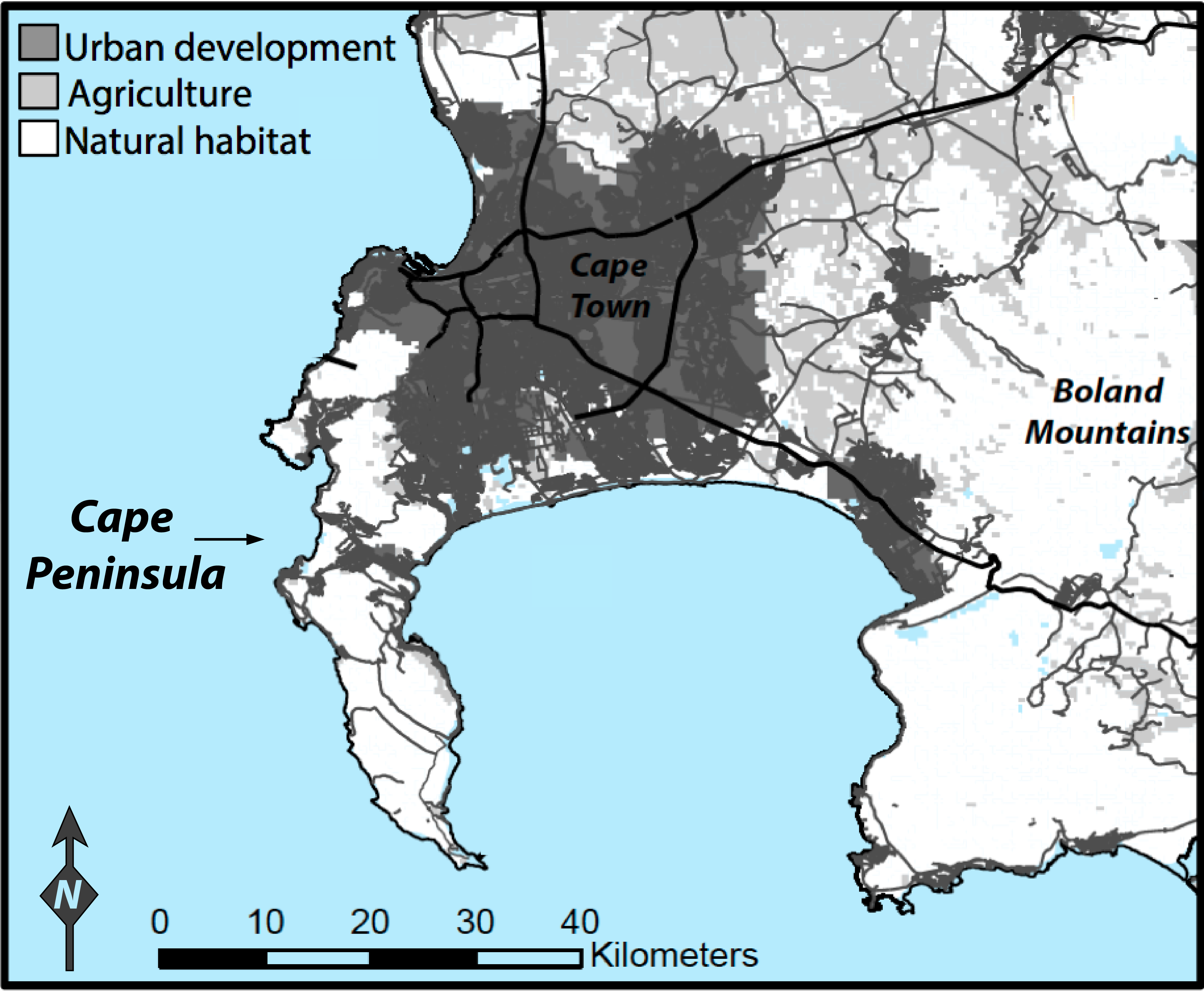 Map of the Cape Peninsula. Cape Town encircles the northern section of the Cape Peninsula, leaving it isolated between city and sea. We are studying how this isolation affects caracal behavior and genetic health.
Map of the Cape Peninsula. Cape Town encircles the northern section of the Cape Peninsula, leaving it isolated between city and sea. We are studying how this isolation affects caracal behavior and genetic health.
We have collected behavioral data from 23 caracals and have found that caracal home ranges overlap extensively at the urban fringe. This suggests increased prey abundance, yet they have 10-fold greater home range sizes compared with caracals in nearby undisturbed habitat. Some adult males have home ranges exceeding 100 square kilometers, this is quite a feat in an area where there is only 220 square kilometers of available habitat! For a species that is supposed to be solitary and territorial, these findings suggest that habitat changes associated with urbanization may be driving overlap among individuals and reducing territoriality.
Additionally, adults, in contrast with juveniles, use habitat further from urban areas. These findings suggest that juveniles are pushed to marginal edge habitat (see map below), and that they may be more vulnerable to death from vehicle collisions and other causes associated with human activities.
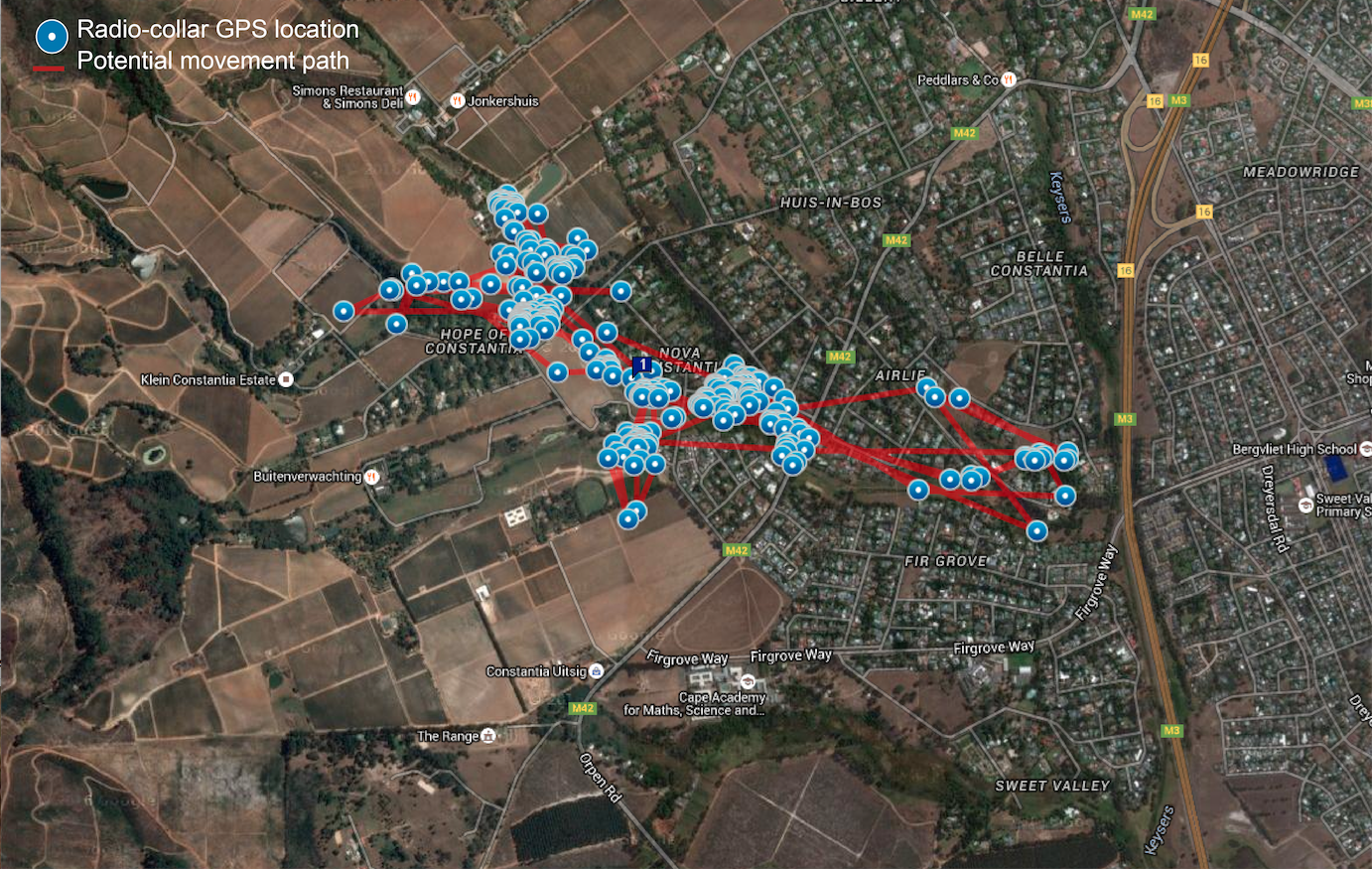 Map of two weeks of GPS movement data for Caracal #21 (C21, a.k.a. Strandloper), a juvenile male. Blue circles are GPS locations and red lines are potential movement paths. As a juvenile male, C21 may be pushed to the urban edge as he seeks territory unoccupied by other dominant males.
Map of two weeks of GPS movement data for Caracal #21 (C21, a.k.a. Strandloper), a juvenile male. Blue circles are GPS locations and red lines are potential movement paths. As a juvenile male, C21 may be pushed to the urban edge as he seeks territory unoccupied by other dominant males.
By studying their diet, we are learning that Cape Peninsula caracals frequently prey on birds, but have a variety of other species on their menu including antelope, squirrels, mole rats, mongoose, genets, and hyraxes. The implications of preying on carnivores like genets and mongoose are important because of potential bioaccumulation of commonly used rat poisons through the local food web. In fact, we have discovered that all seven caracals we have tested for rat poison exposure were exposed to the poisons multiple times. Additionally, our fifth captured caracal, a young kitten, died of suspected exposure to rat poison.
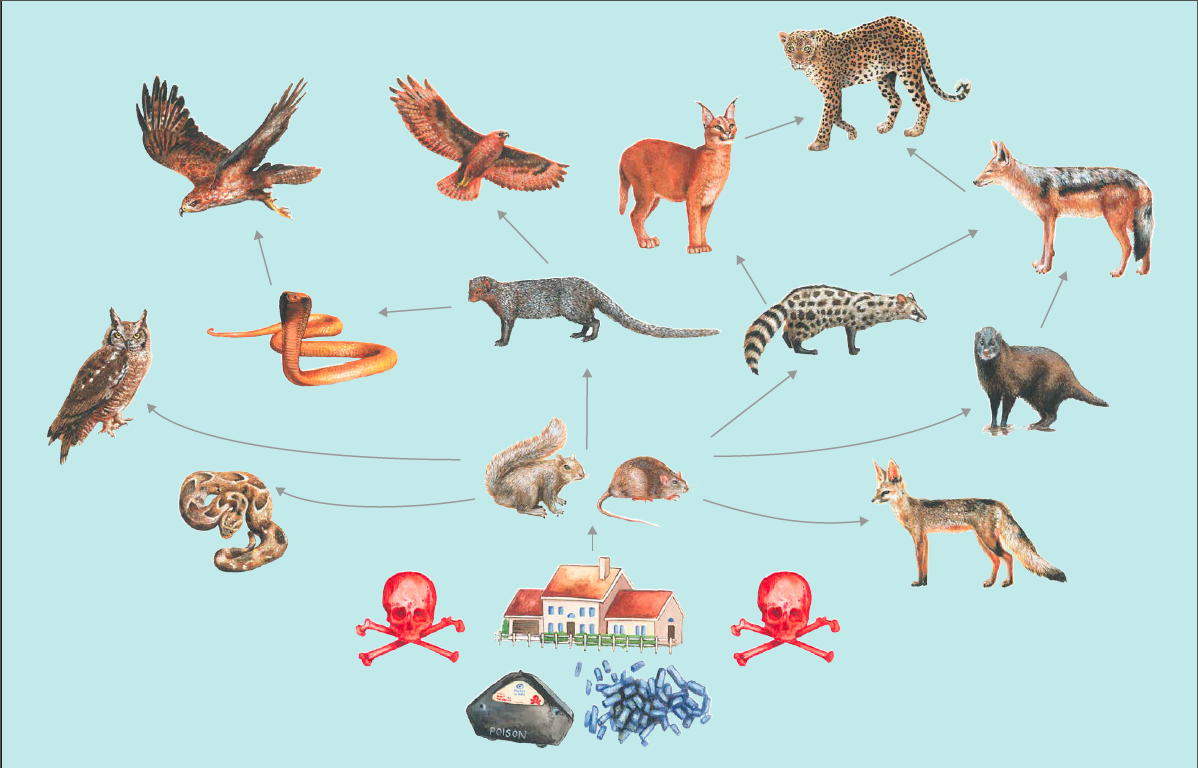 An illustrative diagram of the local food web for the Western Cape of South Africa. Rat poisons used around urban areas do not immediately kill the rodents they are intended for, and the toxic rodents become weakened by poisons and easier to catch as they wander into wildlife habitat. As a result, rat poisons bioaccumulate to affect many species including caracals and other carnivores. Illustration credit: Desiree Smith
An illustrative diagram of the local food web for the Western Cape of South Africa. Rat poisons used around urban areas do not immediately kill the rodents they are intended for, and the toxic rodents become weakened by poisons and easier to catch as they wander into wildlife habitat. As a result, rat poisons bioaccumulate to affect many species including caracals and other carnivores. Illustration credit: Desiree Smith
We have also documented that vehicles and disease are sources of mortality for caracals in the Cape Peninsula, and that in combination with exposure to poison, these urban hazards are likely interacting synergistically to threaten caracals in urban areas.
Finally, our initial genetic analyses are very revealing about the effects of urbanization on genetic isolation. We are working with collaborators who have provided 50 genetic samples from 3 regions in South Africa where caracals are not isolated by urban barriers. Therefore, we are able to assess the role of urbanization in driving genetic change in populations. Our initial results show that caracals in the Cape Peninsula are nearly completely isolated from caracal populations outside the city. The consequence of this isolation is reduced genetic diversity as a result of inbreeding. If genetic diversity is depleted over a long period of time, there may be detrimental health consequences for the caracal population. These findings emphasize the importance of "planning ahead" to build wildlife corridors as urbanization rapidly expands across the globe.

Graph above. Initial genetic results for caracals sampled in 4 areas in South Africa. Each bar represents an individual grouped according to where the sample was collected. The genetic data were analyzed to identify genetic similarities and differences amongst the individuals, which varies according to how much genetic exchange occurs between populations. We identified 2 primary genetic clusters divided by the urban Cape Town barrier (Blue = Cape Peninsula isolated by Cape Town, Green = areas outside of Cape Town). The mixing of the 2 genetic clusters in individuals in each group indicates the degree of genetic exchange between populations. The stark contrast in genetic cluster assignments between urban, and non-urban caracals suggests that Cape Town is the most important barrier (more so than geological features) to genetic exchange between populations across all the caracals in the study.
This project is a partnership between the nonprofit, Cape Leopard Trust, Unversity of Cape Town, and Universities of California Santa Cruz and Los Angeles.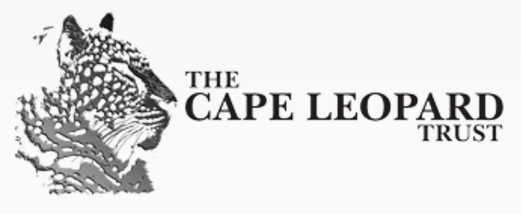



Project Backers
- 132Backers
- 147%Funded
- $7,385Total Donations
- $48.37Average Donation

